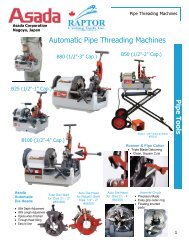March 2006 - Plumbing & HVAC
March 2006 - Plumbing & HVAC
March 2006 - Plumbing & HVAC
You also want an ePaper? Increase the reach of your titles
YUMPU automatically turns print PDFs into web optimized ePapers that Google loves.
RefrigerationCSI: Compressor Service InvestigationTechnician tackles refrigeration service mysteryBy John Carr, C.E.T.Fig 1: Allan finds thisalarm waiting on hiscomputer screen.MONDAY, 3:09 A.M.: Allan awakesto his cell phone ringing. He is on call, sohe knows there is a problem with one of the many systems heservices. He gets out of bed and walks to his computer in the next room. In the hallwayhe can hear the pinging sound of the alarm and as he enters the room he seesthe screen flashing “ALARM.” In moments he has hit the Enter key and is reading thealarm report.3:51 A.M.: Allan is in his service truck heading towards Velton Foods on MadisonStreet. He thinks about the refrigeration warehouse systems operated by Velton Foods.The information in the case beside indicates:Unit 28Type: FreezerOperating Temp: -22.2°C (-8.0°F)Compressor Rack: 4 – 40 Hp Screw Type,3500 RPM, Electrical rating 440/460-3-60.Rack Capacity: 190,325 KW (650 MBTU/Hr) with unloading down to 50%.Condenser: 225,000 KW (768 MBTU/Hr) 12 fans, divided into three stages.Refrigerant: R-22Refrigerant Oil: POE 100 (Rack has oil cooling)Evaporators: 4 – 48,000 KW (165 MBTU/Hr)Defrost Type: Hot Gas4:16 A.M.: Allan enters Mechanical Room 3. Every compressor rack is operatingwith the exception of Unit 28. He knows what the condition is, but he looks at thecontrol readout screen anyway.With confirmation complete, he punches in the key code to find out the conditionof the compressor at the moment of failure4:18 A.M.: Allan recognizes right away that oil pressure failure is the condition,but has to find out why oil pressure was lost. The system had worked for over twoyears without oil failure problems, so the basic piping design was sound. After a fewmore control module checks, Allan discovers that the oil level switch circuit is open.This indicates that there is a low oil condition.4:35 A.M.: After checking the rack thoroughly for oil leaks, Allan finds no indicationthat oil has left the system. Oil is not likely to pass through the oil separator, sohe considers the possibility of an oil-level switch failure. He removes the wire to theFig. 2: ControlModule read outconfirms alarm.Fig. 3: The controlmodule lets Allanknow the condition ofthe rack at midnight,prior to failure.Fig. 4: The place onthe compressor rackwhere field changesallowed the oil-levelswitch to be heated bythe discharge line.SNC-Lavalin ProFac Inc is the industry leader in Canada, providing a fullrange of integrated facility management services and solutions toClients in various sectors. Nationally, SNC-Lavalin ProFac providesintegrated management for over 110 million square feet of real estate.Within that portfolio, the Public Works and Government ServicesCanada (PWGSC) account is comprised of 319 buildings acrossCanada with a total area of over 31 million square feet.SNC-Lavalin ProFac Inc. conducts its procurement through bestpractices that honour both the spirit and the letter of openness andtransparency and is pleased to announce that the open procurementactivities for PWGSC service contracts across the country will betendered using the Private Tenders section of the MERX tenderingservice (www.merx.com - Private Tenders tab).For those who do not have Internet access, the open tenderingopportunities can be accessed by phone at 1-800-964-MERX (6379).Potential proponents can register with MERX online to access allProFac postings for the PWGSC contract. Potential proponents canset-up a user profile on MERX to receive automatic notification ofopportunity postings or visit the website regularly to view currentpostings. All questions about registering with MERX can be directedto merx@merx.com or 1-800-964-MERX (6379).Circle Number 129 for More Informationoil level switch at the base of the oil separator and checks it with his ohmmeter. Themeter reads 0 ohms, indicating that the switch is closed.4:36 A.M.: Extensive searches have led Allan to check for continuity between theoil-level switch and the control module. Here he finds an open circuit. But why, hethinks? This is a 220-volt control circuit, so if there was an electrical short at sometime there would have been a different alarm, and sooner.4:58 A.M.: Allan has just finished replacing the wiring from the control module tothe oil-level switch. He checks for continuity and all is normal. The next step is startup.5:12 A.M.: The rack is running and the control module reads that all is normal,with the readings similar to what was showing at midnight. The box temperature isbeginning to move down slowly.7:52 A.M.: Allan and two other refrigeration mechanics are inspecting the wirefrom Rack 28. They find a discolouration on the wire at the point where it wouldenter the panel just before its connection to the control module. Allan cuts the wireand peals back the discoloured insulation. He finds that the wire too, is discolouredand broken. Now Allan is concerned about the new wire and its location.12:02 P.M.: Back at the warehouse, Allan checks the wiring and finds that all isfine, but he does spot something that is not quite right. The back of the control panelis placed very close to the oil discharge line from the oil separator. This must havebeen a field change made by someone else. He insulates the wires, checks the controlmodule to see that all is normal and heads on out to his next call.Detective’ John Carr is the continuing education coordinator at SAIT Polytechnic inCalgary. He can be reached at john.carr@sait.ca.30 <strong>Plumbing</strong> & <strong>HVAC</strong> Product News – February/<strong>March</strong> <strong>2006</strong> www.plumbingandhvac.ca
















